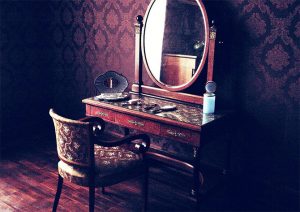Packing and Moving Pictures
The primary danger to a picture during the moving process is a puncture or broken glass. Below is shown a medium-sized glass picture being bubble-wrapped to protect its glass. It’s best to use big bubble wrap for this task but if you only have small bubble wrap, then that will work also but it requires two to three times as much material because you need to wrap the picture more times with it. Instead, you can also wrap it completely with a blanket and tape the blanket in place (tape peels right off of blankets later with no residue).
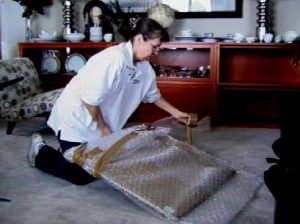
Bubble wrap is good for protecting the glass on pictures but it is not good protection for frame edges or corners because if the bubbles break (which they easily do on edges and corners), there is no protection!
Blanket wrap padding after bubble wrapping is better for all around protection but even better than just bubble wrapping and padding is to also box pictures for triple protection. A properly boxed picture in a mover’s picture box is shown below.
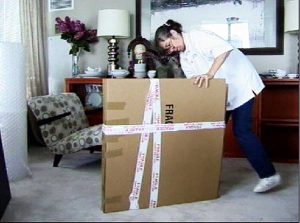
If you can’t obtain mover’s picture boxes from a mover’s supply company within your vicinity, then instead, just slip each padded picture right into any flattened out carton that’s big enough to hold it. Then, the box’s edges should be taped tight together to seal the box in order to protect the picture’s frame and so that the picture won’t slip out.
If instead, you were to use pieces of cardboard taped over each side of the picture, the picture’s edges may still be exposed. If you pack a picture this way, it’s much better to go on and wrap the cardboard around all of the edges and the corners of the picture and then tape it all shut.
Oil paintings should not be bubble wrapped first because bubble imprints can be left on the oil. Just box up an oil painting
For even better protection for oil paintings, purchase some non-acidic plastic wrap from an art store and put that over the face of the painting. Then any of the above methods for further protection may be used to bubble wrap, pad and box it.
Plastic foam wrap may also be used on oil paintings as shown below but use quite a few layers for good protection. Then, use any of the

Often, smaller pictures can be wrapped together, facing one another with something soft like a towel or foam wrap in between them as shown in the 3 picture sequence below. Here, 3 small pictures are being wrapped together.
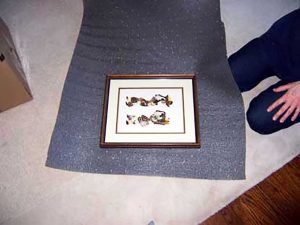
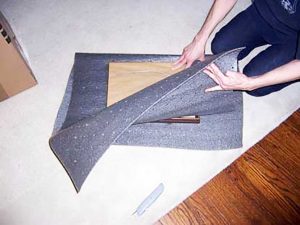
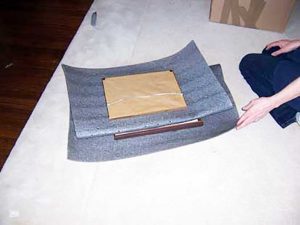
Then, these 3 small pictures are all wrapped up into a taped bundle and placed inside a box with other
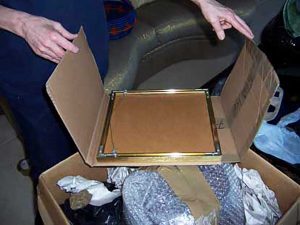
Kinetically speaking, as is shown below, these 3 wrapped pictures lining the box’s side and the
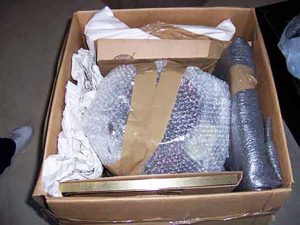
The center piece small vase itself is also protected by each of the pictures positioned on 3 sides and the crushed paper filler on the left side of the box. So the idea is that when packing delicate, fragile artwork in a box you should have all of the things in the box protecting one another in order to have the least chance of damages.
Small pictures and leather-bound award sheepskins can be packed in bundles also if done correctly as shown in the picture sequence below. The first small picture is unique in that it has an attached metal scrollwork hanger.
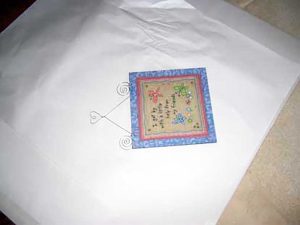
So the award’s leather bound case is placed as a bracing cushion under it. A piece of paper could be put between them.
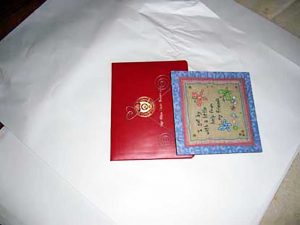
Then a second award leather is placed over the scrollwork in order to brace its top side.
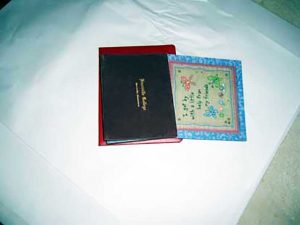
Then it’s all wrapped up in a paper bundle as is.
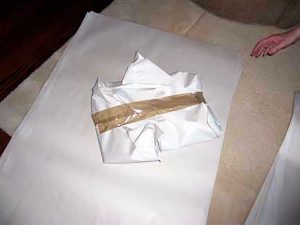
The picture with the scrollwork hanger can’t shift at all when it’s been paper-wrapped as a bundle with other items in this way. Still,
Another method to pack picture bundles is to just put paper between them and box them up as shown in the 2 picture sequence below.
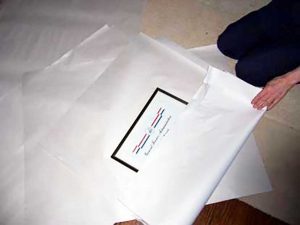
A second similarly sized framed picture is placed over the first one with 2 sheets of paper in between.
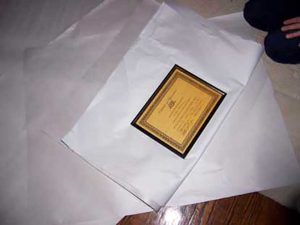
Then, they’re bundled up and placed into the sides of a box with other
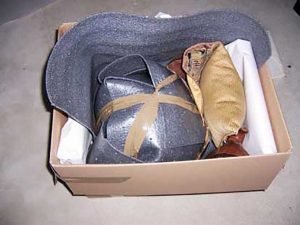
Packed small pictures make a very good bracing for other fragile items when lining a box as shown above.
How to Pack Mirrors for Moving
Mirrors are handled similarly to pictures as will be shown in the mirror padding picture sequence below.

This mirror could have been bubble-wrapped first for extra protection but the
Notice the way the packer tucks the pad in under each side of the picture in the 2 picture sequence shown below.
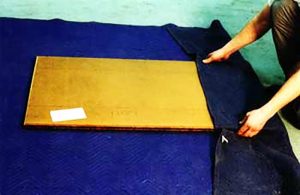
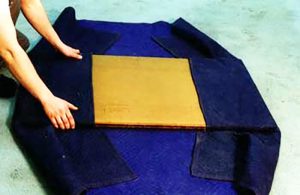
Then, the packer gives the mirror’s pad a couple of folds to fully shroud it and he or she seals each end with tape.
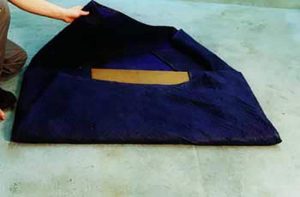
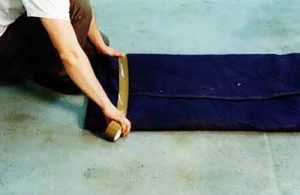
Voila, it’s ready to be boxed.
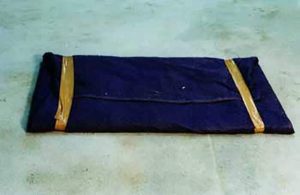
GLASS
The following is a picture sequence for padding up a round glass table top.
These pictures are of a table top but they could also be of a round mirror or a round picture. Each would be handled in the same manner with this easy padding sequence.
First, center the circular glass on the pad.
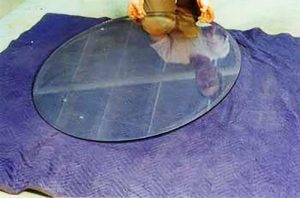
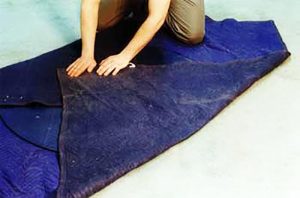
Finish shrouding it and tape it up. Then put it into a picture box for best protection.
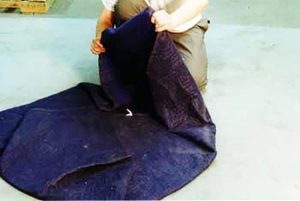
How much padding and boxing being done on the pictures or glass all depends on how they are going to be handled.
If you’re going to put a picture or a mirror on a truck, use more protection than if you’re going to carry it yourself in your car. If you’re going to ship it by a common carrier, it’s a guarantee that it will be mishandled by shipping personnel and probably get broken, so pack it well enough to be drop-kicked! Common carriers are notorious for throwing boxes around, no matter how much fragile labeling is present. Double-boxing is a good way to prepare things for shipment by common carrier.
Collages and/or Italian glass / mirrors are very difficult to protect during moving without breaking pieces off of them. It’s best to just hand carry these kinds of items with at most, a light foam wrap over them to hold everything together.
Custom Crating
The expensive pictures require extra care when preparing to move. In most cases custom crating is required to ensure the safe transportation of expensive and heavy pieces of artwork and pictures with heavy frames.
Usually, the wooden crates are crafted on
In most cases, customers that require such service are also getting additional insurance just in case something unexpected
When handling the transportation of delicate pieces of art, you may want to have a climate-controlled moving truck to make sure those pieces don’t get damaged by the harsh conditions in the trailer during transportation.
Packing expensive pictures, paintings and other pieces of art is trickier than you think due to their fragile nature. Do what’s best for your valuable framed art and hire professional packers with impeccable reputation and years of experience.

